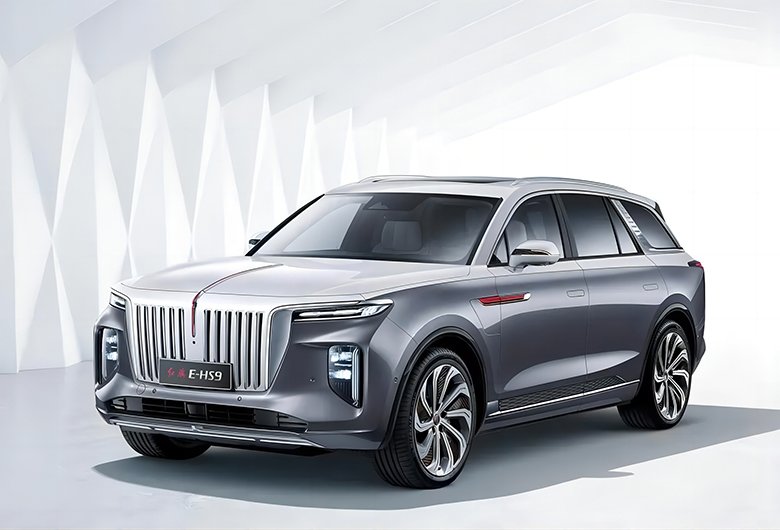
Description
- APPEARANCE
- INTERIOR
- SEAT SPACE
- DETAILS
Hongqi E-HS9 is developed based on Hongqi’s new FME platform. The body and chassis are largely made of lightweight aluminum alloy, and the suspension system adopts a front double wishbone and rear multi-link structure, equipped with air springs and CDC variable damping shock absorbers. As Hongqi's current flagship SUV model, the E-HS9 can be said to be equipped with the strongest configuration compatible with the FME platform. The combined power of the front and rear dual motors reaches 405kW and the maximum torque reaches 800 Nm.
From the perspective of energy density, the capacity density of this power battery has reached 206Wh/kg, and the overall performance is still very good. More importantly, the FME platform battery pack 9 can reach a durability of 10 years or 300,000 kilometers, so there is no need to worry about the life of the battery pack. In terms of motors, E-HS9 is equipped with a permanent magnet synchronous motor 9 from Jingjin Motor. Its motor is 160kW and the rear motor is 245kW. The maximum comprehensive torque can reach 750N·m9 and the peak power is 405kW. Its peak power can be output continuously for 30 seconds. During maintenance, With a mass of nearly 2.7 tons, it can accelerate to 100 kilometers in 4.8 seconds, which is good data. The power output is stronger than that of the mid-range machine, and its maximum speed performance is also good, reaching 15,000rpm. Although this data is not as good as that of Ji Krypton 001, it can definitely enter the first echelon. 16500r/min and Tesla Model 3’s 15500r/min, but the difference is not big.
This motor is equipped with square conductor technology independently developed by FAW. By optimizing the distribution of conductors in the stator slot, it reduces eddy current loss 9 and harmonic loss, so that the maximum efficiency of the electric drive system can reach 93%. Therefore, the E-HS9's power consumption per 100 kilometers is good, with the highest power consumption of 19.3kWh/100km, which is better than the 19.9kWh/100km of the Mercedes-Benz EQC and the 21kWh/100km of the Audi e-tron9. As a full-size luxury SUV, this data looks good.
In terms of electronic control, Hongqi has made many attempts on the E-HS9. E-HS9 has 7 driving modes: economy, standard, sport, extreme, off-road and all-road conditions, and supports 5 gears of power recovery levels. On top of the basic control functions, Hongqi has also carried out many innovations and explorations.
For example, the design is carried out based on the electromagnetic mechanism, material technology, tolerance sensitivity, power electronics, control strategy and other dimensions of the actual working conditions, including directional optimization of the efficiency of the working condition area, adjusting the loss proportion of the motor, controller and reducer, and refining the iron loss. and copper loss design, balancing current harmonic suppression9 and device loss, and combining with global intelligent frequency control and NVH suppression9, so that the maximum efficiency of the body is greater than 97%, and the maximum efficiency of the system is greater than 93%. In terms of reliability, the electric drive system 9 has completed a total of 3 rounds, 183 assemblies, 29 items in 7 categories, and more than 50,000 hours of bench testing. The assessment intensity is 6 times the national standard. The vehicle road test carried out simultaneously has an equivalent mileage of 5.7 million kilometers. Many of the assessment standards are unique to FAW, such as: super-strengthened inverter assessment test under actual load, deep thermal shock test Q, etc. In terms of safety, in response to the special needs of Hongqi's high-performance luxury brand for safety, a three-level safety management and control technical route was formulated, and safety strategies were formulated based on operating mechanisms and full-scenario failure modes, and layered design was carried out. On the premise of fully achieving the ASIL-C level goal, the probability of systemic failure is reduced. In terms of electromagnetic compatibility9 (EMC), FAW's team adopts the system forward design method, implements full-process closed-loop management from product definition and requirement decomposition to design, simulation, and testing, and establishes a system-component-device three-level electromagnetic model9. Complete testing methods accurately measure, optimize design plans and parameters, and achieve Class3 electromagnetic compatibility level.
In terms of NVH, the FAW R&D team has comprehensively reduced radiated noise from the excitation source to the transmission path through more than ten technologies such as adaptive jitter suppression, high-frequency electromagnetic vibration force suppression9, and global variable frequency control. The sound prominence rate in the vehicle NVH evaluation (PR value) is less than 6dB. In the China New Energy Vehicle Competition Q, the three individual tests related to NVH all achieved the highest scores in the competition.
Inquiry
| Model: | E-HS9 |
| NEDC Mileage (KM): | 690 |
| 0-100km/H: | 6.5 |
| L-W-H (mm): | 5209*2010*1731 |
| Drive Type: | Electric Car |
Inquiry Now





























